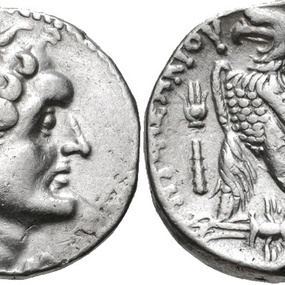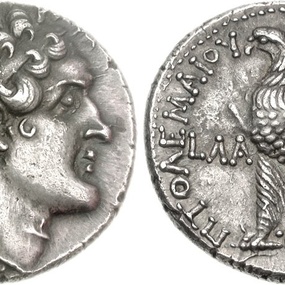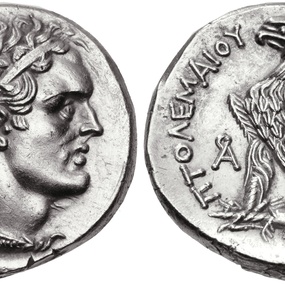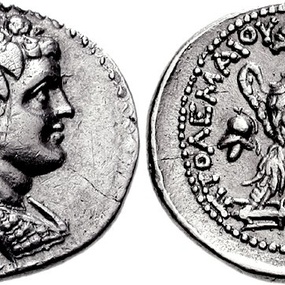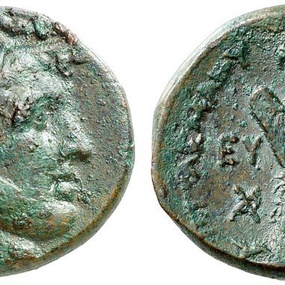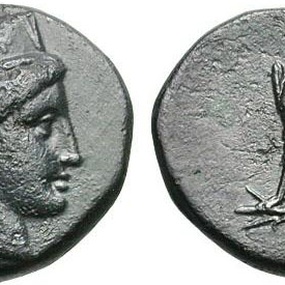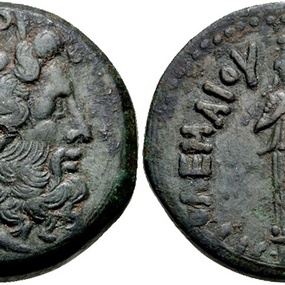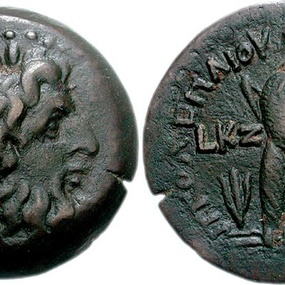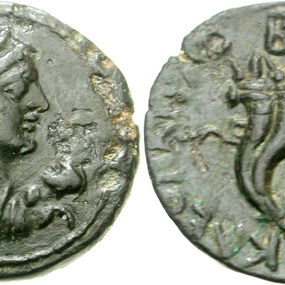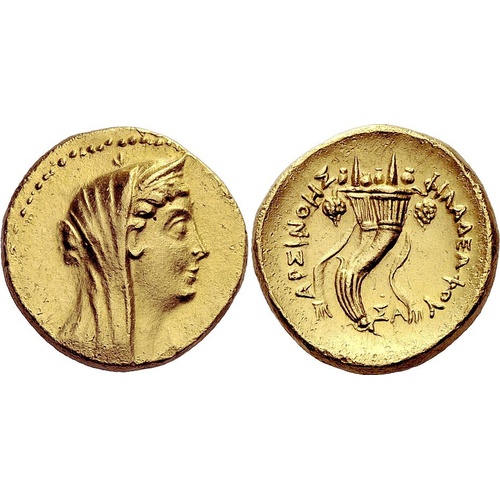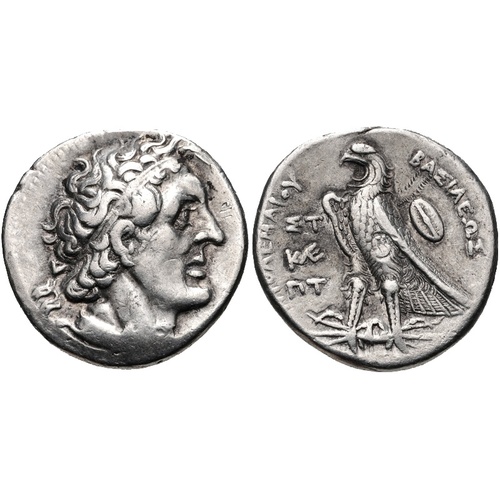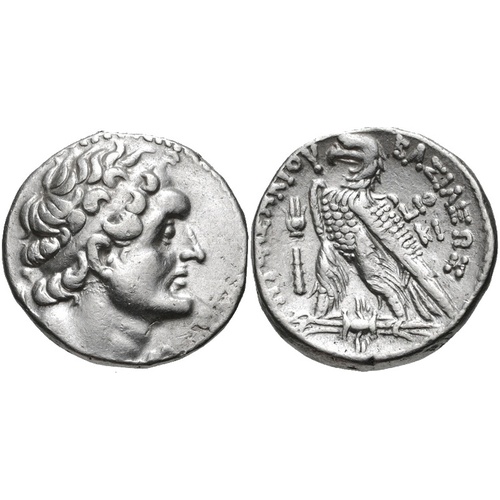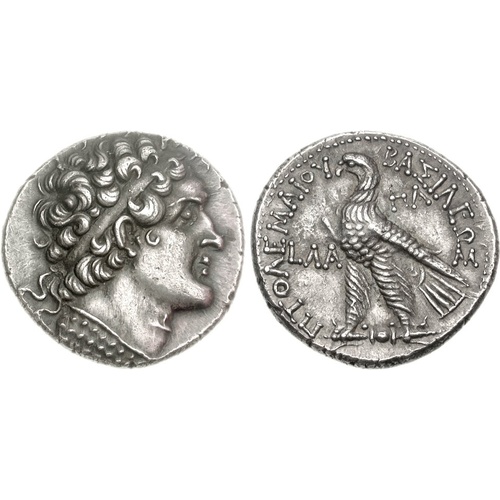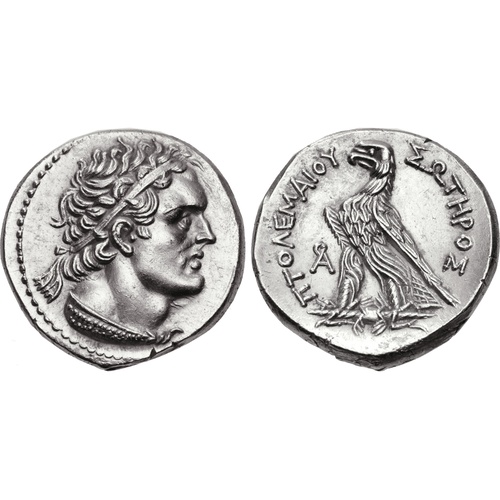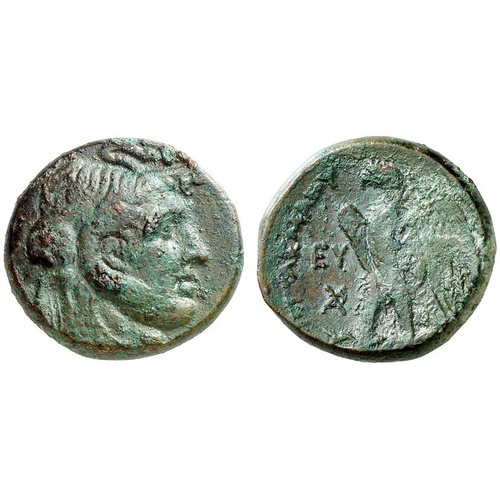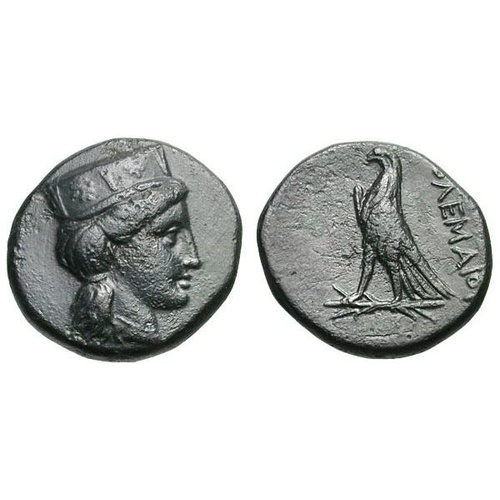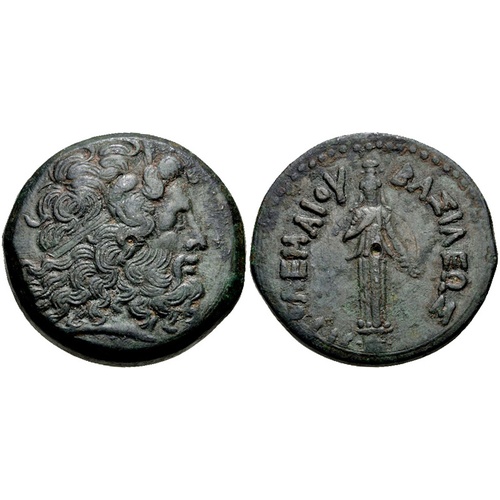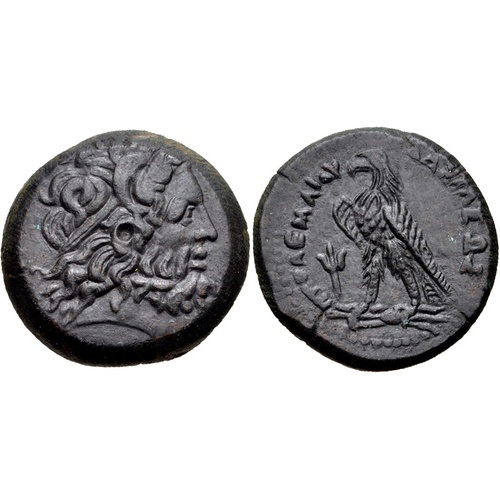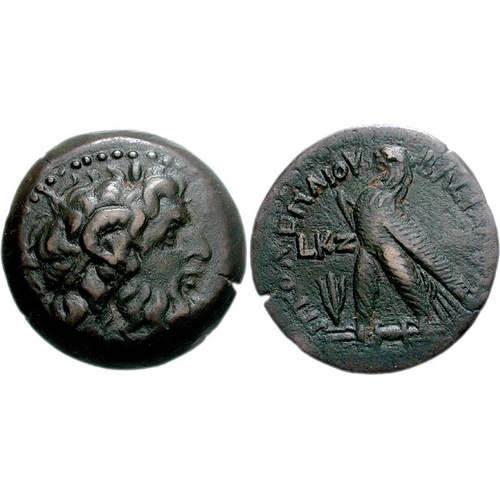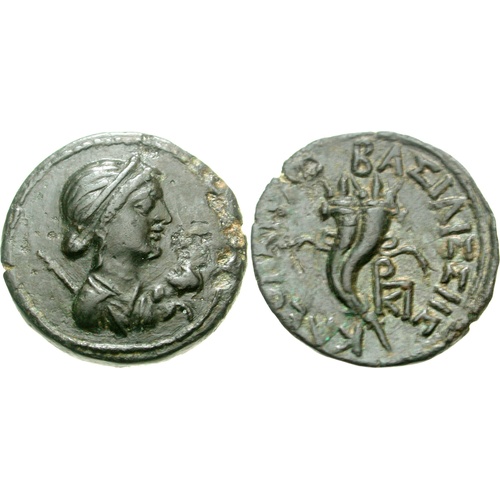The Ptolemaic kings of Egypt struck many series of coins, mainly in Alexandria but also in various mints scattered in foreign possessions, such as Coele Syria and Cyprus.1 While Ptolemy I seeks to establish himself on the island from 321 BC, the Ptolemaic coin production essentially starts from the definitive annexation of Cyprus to Alexandria in 295/4.2 The creation of a closed monetary economy, at the turn of the 4th and 3rd centuries BC, strongly distinguishes the Ptolemaic coins among other emissions from the Hellenistic East. While almost all of the gold and silver coins from this period conform to the Attic standard (drachm = 4.32 g), the Ptolemies adopt a lighter standard (drachm = 3.25 g) and give their money the monopoly of circulation within the borders of the kingdom.3 The obligatory exchange of foreign coins at the gates of the country is generally regarded as one of the main sources of wealth for the Ptolemies throughout their reign. This policy of excluding non-Ptolemaic coins also causes the emission of considerable amounts of gold, silver and bronze coins.
In this global context, the Cypriote production represents a rather complex object of study to discuss as a whole. While the identification of monetary series of the 3rd century attributable to Cyprus still provokes debate, the 2nd-century productions, at least for gold and silver, are much better known. At this point, we must add to this chronological dichotomy the difficulties of classifying the Cypriote bronze series, relatively little studied until now.
The gold and silver coinages from Cyprus
The untraceable coinages of the 3rd century
The identification of gold and silver coins struck in Cypriot mints during the first decades of the Ptolemaic reign has been discussed for a long time. While R.S. Poole attributes several series of tetradrachms and some gold emissions to Cyprus,4 J.N. Svoronos mentions no production of silver coins before the reign of Ptolemy V.5 Both authors finally agree on the attribution of a few mnaieia (heavy gold coins circa 27.8 g equivalent to 100 drachms) because of the presence of ΣΑ letters [for Salamis Fig. 1] or ΚΙ/Κ/ΚΑ (for Kition).6
The conclusions of Svoronos were accepted by virtually all the specialists until the publication of the Meydancikkale hoard (CH 10.269, CH 8.308, CH 7.80) in 1989. This important discovery of 5,315 silver coins (of which 2,158 are Ptolemaic) brings A. Davesne to pose the question anew of a coin production in Cyprus under Ptolemy II (283-246). Based on the coin finds in different hoards, as well as the location of bronze coins in Cyprus bearing the same control marks, the author proposes that important series traditionally classified as Alexandrian to be assigned to Cyprus.7 He separates these series into three groups which he attributed to the mints of Salamis, Kition and Paphos. Although we should probably retain the hypothesis of a multiplicity of workshops, their precise location seems difficult to validate because of the absence of clear marks. Thus, despite the problems posed by this important study (including surveys by F. de Callataÿ),8 the reallocation to Cyprus of vast series of coins from the 3rd century is perfectly convincing.
Following Davesne, C.C. Lorber places in Cyprus a number of new gold and silver varieties.9 However, she proposes that this production was inaugurated as early as the reign of Ptolemy I (323-283) due to the presence of Cypriote tetradrachms in the Phacous hoard (IGCH 1978) and because of links between these emissions and Alexandrian coins minted during the reign of the founder of the dynasty.10 The existence of several workshops is also reasserted: the author is more cautious and evokes "uncertain mints" she distinguishes by numbers: No 9, 10, 19. The first two are likely to be located at Salamis and Kition, the third perhaps at Paphos. The table below summarizes the attributions and the chronological propositions offered by Lorber11:
|
PTOLEMY I (from 294-283) |
Gold. Uncert. mint 9, on Cyprus (Salamis or Kition), from 294 B.C.: Sv. 362a, 357, 374. Uncert. mint 10, on Cyprus (Salamis or Kition), from 294: Sv. 367, 365a. Silver. Uncert. mint 9, on Cyprus (Salamis or Kition), from 294 B.C.: not in Sv. (=Meydancikkale hoard, 4744), Sv. 359, 361, 354, 362, 358, 355, 375, 376, 353. Uncert. mint 10, on Cyprus (Salamis or Kition), from 294: Sv. 245, 246, not in Sv. (=Colosseum Coin Exchange 101, 19 May 1998, 101), not in Sv. (=Robinson 1950, Megalopolis hoard (IGCH 180), No 35, 38), Sv. 368, 369, 378, 366.
|
|
PTOLEMY II (283-246) |
Gold. Uncert. mint 10, on Cyprus (Salamis or Kition), c. 275/4-262/1: Sv. 537. Salamis, c. 261/0-253/2 B.C.: not in Sv. (=Troxell 1983, p. 63, 9), not in Sv. (=Troxell 1983, p. 63, 10), not in Sv. (=Troxell 1983, p. 63, 11). c. 253/2-246 B.C. or later (to 241 B.C.): Sv. 521, not in Sv. (=Troxell 1983, p. 63, 13). Kition, c. 261/0-253/2 B.C.: Sv. 522. c. 253/2-246 B.C. or later (to 241 B.C.): Sv. 523, not in Sv. (=Sotheby’s, 21-22 June 1990, 636), not in Sv. (=Troxell 1983, p. 63, 6). Paphos, c. 261/0-253/2 B.C.: Sv. 520a, not in Sv. (=Troxell 1983, p. 63, 8). c. 253/2-246 B.C.: Sv. 520, not in Sv. (CNG 86, 390). Uncert. mint 21, perhaps on Cyprus, before latter 260s B.C.: Sv. 370. Silver. Uncert. mint 9, on Cyprus, before c. 275 B.C.: Sv. 349, 365, 764. c. 275/4-262/1: 528, 527, 530, 525, not in Sv. (=Keen forth., Iraq el-Amir hoard (CH 10.268, CH 9.497), No 66), Sv. 529, 526. From 261/0: 396, not in Sv. (=BnF, 1994.170), Sv. 395, 392, 397, not in Sv. (=Colosseum Coin Exchange 99, 3 Feb. 1998, 101), Sv. 398, 407, 391, 404, not in Sv. (=Ponterio 70, 13 July 1994, 363), not in Sv. (=BnF, Dattari coll., Z.2884,88), Sv. 393, not in Sv. (=Ponterio 70, 13 July 1994, 364). Uncert. mint 10, on Cyprus (Salamis or Citium), c. 275/4-262/1: 538, 536, 546, 544, 542, 542a, not in Sv. (=BnF, Dattari coll., Z.2884,134), Sv. 364, Sv. 364 var. (= Cederlind 178, 76), 539, 540, 541, 543, 545, not in Sv. (=BnF, Dattari coll., Z.2884,142), not in Sv. (=BnF, Dattari coll., Z.2884,132), not in Sv. (=ANS 1944.100.75896), not in Sv. (=ANS 1944.100.75895, BnF, Dattari coll., Z.2884,136). From 261/0 B.C.: Sv. 402, not in Sv. (=ANS 1944.100.75912, BnF, Dattari coll., Z.2884,96), not in Sv. (=commerce 1994), Sv. 541a, 401, 405-406, 399, 400, not in Sv. (=BnF, Dattari coll., Z.2884,94), Sv. 402a, not in Sv. (=Meadows forth., Syria 1981 hoard, 354). Uncert. Mint 19, on Cyprus (perhaps Paphos), from c. 275 B.C.: Sv. 531, not in Sv. (=CNG e-Auctio 256, 154), Sv. 532, 533, 534, 535, 524. c. 261/0 B.C. and perhaps shortly after: not in Sv. (=Israel Museum, 11146?), Sv. 388, 390, 389, 403. Uncert. mint 20, on Cyprus, probably shortly before 261/0 B.C.: not in Sv. (=CNG e-Auction 226, 19 October 2011, 200), Sv. 394, not in Sv. (=Forum Ancient Coins 2008). From 261/0 B.C.: not in Sv. (=BnF, Dattari coll., Z.2884,89), not in Sv. (=Lanz 123, 30 May 2005, 267), not in Sv. (=A.D. Philippidis coll., Hicksville, N.Y., P-2007-12-09.001), not in Sv. (=Seyrig 1950, No 42, Khan el-Abde 1938 hoard (IGCH 1597)). Uncert. mint 21 , perhaps on Cyprus, before latter 260s B.C.: Sv. 371, not in Sv. (=A.D. Philippidis coll., Hicksville, N.Y., P-1999-03-06.001), Sv. 372. Uncert. mint 22, perhaps on Cyprus, perhaps Ptolemais (Ake), before latter 260s B.C.: Sv. 373. |
Table 1: The Coin Production in Cyprus during the 3rd Century according to Lorber, forthcoming.
The feature of the Cypriote productions during the 3rd century, as proposed by Lorber, enshrines the idea of a coin production center in addition to the province of Coele Syria. Alongside one-off gold emissions, tetradrachms were struck in large quantities in two and later three mints. Although the exact timing of strikes is still subject to debate, it seems certain that nearly all, or perhaps all these coins were issued in the first half of the 3rd century,12 as in the other Ptolemaic regions, especially in Phoenicia.
Locating and dating the coin productions: the 2nd century BC
The main series
In the 2nd century BC, most of the Cypriote emissions are readily identifiable and datable because of the affixing of the first two letters of the workshops of Salamis (ΣA), Kition (KI), and Paphos (Π then ΠA), and a date according to a regnal computation (preceded by the sign "L" to indicate that it is a year) both on gold (mnaieia) and silver coins (mainly tetradrachms) [Fig. 3].13
Despite these obvious advantages, two difficulties had to be overcome before reaching a satisfactory classification of these coinages. The first concerns the attribution of different years of reign to the various rulers of the 2nd century BC. Poole dates the first tetradrachms to the reign of Ptolemy IV14 and Svoronos lowers them to the accession of Ptolemy V in 204 BC.15 The discovery of the Paphos hoard (CH 4.68, CH 2.106, IGCH 1477: 2,484 Ptolemaic tetradrachms, published in 1976) allows I. Nicolaou and O. Mørkholm to resolve these chronological problems with important complements in 1984 by the latter author with A. Kromann about the early issues.16 Tetradrachm series produced in Salamis, Kition and Paphos are all inaugurated in the second part of the reign of Ptolemy V, from the late 190s and ended in the early 80s (105/4 BC in Kition). The second problem concerns the ΠA mark, traditionally associated with Paphos. The occurrence of the same letters on the reverse of Alexandrian tetradrachms from 155/4 BC makes it difficult to distinguish them from the Paphian production. Faced with this phenomenon, Poole suggests a transfer of the Paphos mint to Alexandria in 146/517, while Svoronos, although sensitive to the arguments of the British author in his commentary,18 in his catalogue he attributes almost all coins with ΠA to Alexandria. It is, finally, the study of hoards which leads E.T. Newell (Keneh hoard: IGCH 1708)19 and Mørkholm (Paphos hoard)20 to offer a convincing separation of coins with ΠA between the two workshops, mainly based on stylistic features [Fig. 4].21
The other series
For the sake of completeness, we must add two more coin series minted in Cyprus in the 2nd century BC. First, the study of coins of an “uncertain era” has generated much debate since the article of Mørkholm and his proposal to assign them to Aradus, ally of the Seleucids, despite their Ptolemaic weights, types and legends.22 R.A. Hazzard and F. Duyrat reject this hypothesis and propose attribution of these emissions to Pelusium for the first author,23 and to the eastern Nile Delta or Coele Syria for the second one.24 A few years later, Lorber proposed that all the coinage comes from Cyprus, possibly from a workshop located in the eastern part of the island.25 The difficulty of the different specialists to reach an agreement about the place of issuance is mainly due to fact that no proposal can perfectly fit with all the data available for the whole coinage, which covers a period of over 75 years. With regard to the various elements (style, circulation, elemental analysis), it seems better to consider that the “uncertain era” coinage was issued in a succession of different mints over the course of its history. Also, only coins dated from 193/2 to 171/0 (year 70 to 92) must be regarded as Cypriote [Fig. 5].26
Last to be considered is the coinage of silver didrachms, drachms and other fractions with royal portraits, such as that of Dionysus (only diademed portraits on the smallest denominations),issued in Cyprus between circa 168 and the first years of the 1st century BC [Fig. 6].27
Except for the coinage of an "uncertain era," all these series are interrupted between the end of the 2nd century and the first decade of the 1st century BC (89/8). Today, no gold or silver issue is documented for the last fifty years of the Ptolemaic reign over Cyprus.
Balance
The gold and silver coin production in Cyprus covers approximately two centuries, between the end of the reign of Ptolemy I (from 294) and the early 80s BC. The structure changes little over this period. Mainly composed of tetradrachms, these productions are neither regular nor continuous. In the 3rd century BC, the concentration of emissions in the reigns of Ptolemy I and Ptolemy II seems to imply a closing of the different mints for over fifty years. In the next century, these interruptions do not stop but are significantly shorter (a few years). Die studies have highlighted modest phases of production (about 1 to 2 obverse dies in each mint per year) alternating with peaks of production (5 to 10 dies a year). This phenomenon must be related to the coexistence of several workshops on an island of modest size (9,251 sq. km).28 For the 3rd century BC, Davesne and then Lorber noted the existence of links between the different production centers (sharing control marks or exchanging obverse dies). In the 2nd century BC, the coincidence of peaks of production and the sharing of the metal stocks occurred in addition to the use of the same obverse dies in several workshops and the sharing of symbols as control marks.29 These considerations lead us to envisage a centralized management of monetary production at the level of the island, probably under the responsibility of the strategos. Research devoted to the 2nd century allowed the highlighting of a strong link between variations in these productions and the different military conflicts. Despite this, links between the island and Egypt have been identified. Lorber remarks the use of Alexandrian control marks on the coins of the island during the 3rd century BC.30 Such approximations (style, use of ΠA, similar metal stocks, and so on) have also been established for the 2nd century BC between coins minted in Paphos, the administrative capital of Cyprus, and Alexandria.31
The Cypriote bronze coin production
The bronze coinages minted in Cyprus have not been studied as a whole until now. These coins were, however, studied through catalogues (such as those of Poole, Svoronos or Mørkholm and Kromann)32 or on the occasion of the publication of excavation coins, especially from Paphos,33 Kourion,34 Amathous,35 Kition36, Salamis37 or from Israel.38 Nevertheless, most of the attributions are dependent on choices made for tetradrachms when they have the same control marks. In the recent publication of Alexandria excavations coins, O. Picard and T. Faucher note the almost total absence of coins minted outside Alexandria.39 This has enabled the authors to confirm or deny the attribution to the mint of the Egyptian capital for many varieties. Unfortunately, it is quite different in the provinces of the kingdom, and especially in Cyprus, where excavations have yielded many coins struck outside of the island, including coins from Alexandria.40 In this context, it seems difficult to consider automatically that the bronzes discovered in Cyprus come from a local mint. The integration of the island in the Ptolemaic monetary system goes far beyond the circulation of Egyptian coins. First, it appears that the coins minted on the island perfectly match with the metrological systems successively in place in Egypt, at least during the 3rd century. Similarly, P. Keen points out that some bronze coins strongly attributed to Cyprus are of the same types as the Alexandrian coins: head of Alexander or Zeus Amon on the obverse and an eagle standing on a thunderbolt on the reverse [Fig. 7].41
However, Keen recalls the use of a specific Cypriote iconography,42 mainly through the representation of Aphrodite, whose cult is so important in Cyprus, particularly in Paphos.43 The head of the divinity with a polos adorns the obverse of emissions of Ptolemy Soter after 294 BC [Fig. 8].44 Under the reign of Ptolemy III (247/6-222) the archaic cult statue of the divinity takes up the reverse of bronze coins [Fig. 9]. Finally, it is evoked through the affixing of a lotus flower on the reverse of many coins that may date from the early years of the reign of Ptolemy III, to the end of the reign of Ptolemy VI (145) [Fig. 10].45
Other elements allow us to suspect a Cypriote origin. It is primarily the shape of coins: frequently specific enough to recognize a non-Alexandrian production. Style, particularly the portrait of Zeus Amon, is often different from the Egyptian model. In the 2nd century BC, the presence of different symbols on many varieties of gold and silver has a parallel on some bronze coins. These symbols may appear permanently on a particular series (the lotus flower), or occasionally or even annually as on the tetradrachms.
In order to date these coins, modifications of Ptolemaic coins by the Seleucid troops during their brief occupation of the island in 168 BC (countermarks, erased legends) make a solid basis for establishing the chronology of the emissions of this period.46 Moreover, some varieties are also dated according to a regnal era, especially under the reign of Ptolemy VIII [Fig. 11].
The royal coinage ended with the annexation of Cyprus by the Romans in 58 BC. Some bronze coins were again issued by Cleopatra VII when Julius Caesar returned the island to her authority in 48/7.47 These include a particularly spectacular type representing the queen as an Aphrodite holding Caesarion in her arms (the son she had with Caesar) as an Eros [Fig. 12].
Conclusion
Coinages produced in Cyprus under Ptolemaic rule have generated the interest of numerous specialists – archaeologists, numismatists and historians – since the late 19th century. The accumulation of work enables us to outline a fairly coherent picture of all monetary production over this period of time. If the 2nd-century gold and silver productions are better known, further studies should be undertaken about other series. Though our knowledge of Cypriote emissions of the 3rd century has progressed considerably over recent decades, it is still necessary to undertake a study specifically dedicated to this coinage in order to assess its size, organization and functions within the Ptolemaic kingdom. If the indices do not fail to identify the Ptolemaic bronze coins issued in Cyprus, a comprehensive study is nevertheless essential to determine the classifications and specify the chronology. In this light, Daniel Wolf envisages a metrological study of 2nd-century Cypriote bronze coins.48 The recent publication of Alexandrian excavation coins provides a strong base for the study of the bronze emissions from Cyprus. It is precisely in this context that T. Faucher and J. Olivier have recently undertaken a work on these issues for the entire Ptolemaic period.


